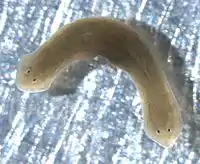Dugesia japonica
Dugesia japonica is a species of dugesiid triclad that inhabits the freshwater bodies of East Asia. Because it is under the genus Dugesia, it is also sometimes considered a type of planarian.[2]
| Dugesia japonica | |
|---|---|
 | |
| Two headed D. japonica that regenerated from a trunk fragment exposed to Praziquantel.[1] | |
| Scientific classification | |
| Kingdom: | |
| Phylum: | |
| Order: | |
| Suborder: | |
| Family: | |
| Genus: | |
| Species: | D. japonica |
| Binomial name | |
| Dugesia japonica Ichikawa & Kawakatsu, 1964 | |
Phylogeny
D. japonica position in relation with other Dugesia species after the work of Lázaro et al., 2009:[3]
| Dugesia |
| ||||||||||||||||||||||||||||||||||||||||||||||||||||||||||||||||||||||||
Space Experimentation
A study was published in 2017 in which a Dugesia Japonica trunk fragment had been sent into space, and grew with two heads, one on either end of the trunk.[4] However, the influence of space conditions on this phenomenon is debated.[5]
References
- Nogi T, Zhang D, Chan JD, Marchant JS (June 2009). Keiser J (ed.). "A novel biological activity of praziquantel requiring voltage-operated Ca2+ channel beta subunits: subversion of flatworm regenerative polarity". PLoS Neglected Tropical Diseases. 3 (6): e464. doi:10.1371/journal.pntd.0000464. PMC 2694594. PMID 19554083.
- Pan HC, Fan J, Wang FF, Sun Z (March 2008). "Effect of medium Ph on population growth, asexual reproduction and activity of six enzymes of Dugesia japonica. Acta Hydrobiologica Sinica". Acta Hydr Sin Acta Hydrobiologica Sinica. 3.
- Lázaro EM, Sluys R, Pala M, Stocchino GA, Baguñà J, Riutort M (September 2009). "Molecular barcoding and phylogeography of sexual and asexual freshwater planarians of the genus Dugesia in the Western Mediterranean (Platyhelminthes, Tricladida, Dugesiidae)". Molecular Phylogenetics and Evolution. 52 (3): 835–45. doi:10.1016/j.ympev.2009.04.022. PMID 19435604.
- Morokuma J, Durant F, Williams KB, Finkelstein JM, Blackiston DJ, Clements T, et al. (April 2017). "Planarian regeneration in space: Persistent anatomical, behavioral, and bacteriological changes induced by space travel". Regeneration. 4 (2): 85–102. doi:10.1002/reg2.79. PMC 5469732. PMID 28616247.
- Sluys R, Stocchino GA (August 2017). "Bipolarity in planarians is not induced by space travel". Regeneration. 4 (4): 153–155. doi:10.1002/reg2.90. PMC 5743782. PMID 29299320.
| Wikispecies has information related to Dugesia japonica. |
This article is issued from Wikipedia. The text is licensed under Creative Commons - Attribution - Sharealike. Additional terms may apply for the media files.